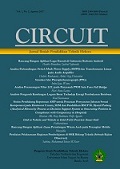Analisa Perbandingan Switch Mode Power Supply (SMPS) dan Transformator Linear Pada Audio Amplifier
DOI:
https://doi.org/10.22373/crc.v1i2.2079Keywords:
Linear Transformer, Audio Amplier, Eficiency, SMPSAbstract
The Advantages of electronics equipment requires the increased efficiency and technology to reduce the use of electrical energy. The electrical equipment in residential energy consumption is the dominant burden on electricity supply service. Audio Amplifier is a widely used household appliance in general based on the linear transformer. A Linear transformer has much deficiency such as dimensions of equipment and the use of technology control systems which less of good and large voltage drop. Because of that, the design of Switch Mode Power Supply (SMPS) model would be a replacement linear transformer. In this research, we will compare the performance of Linear Trafo with SMPS specification +/- 35VDC - 350W. By making modifications to SMPS on the transformer windings which could be seen as the significant comparison to the use of equipment.Downloads
Published
2017-11-02
Issue
Section
Articles
License
Authors who publish in CIRCUIT: Jurnal Ilmiah Pendidikan Teknik Elektro agree to the following terms:
- Authors retain copyright and grant the journal right of first publication with the work licensed under a Creative Commons Attribution-ShareAlike 4.0 International License (CC BY-SA 4.0) that allows others to share and adapt the work with an acknowledgement of the authorship and initial publication in this journal
- Authors are able to enter into separate, additional contractual arrangements for the non-exclusive distribution of the journal's published version of the work (e.g., post it to an institutional repository or publish it in a book), with an acknowledgment of its initial publication in this journal.
- Authors are permitted and encouraged to post their work online (e.g., in institutional repositories or on their website) prior to and during the submission process, as it can lead to productive exchanges, as well as earlier and greater citation of published work. (See The Effect of Open Acces)

